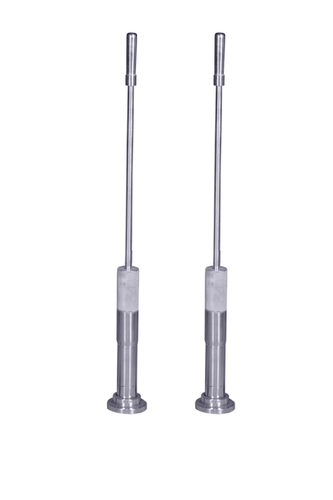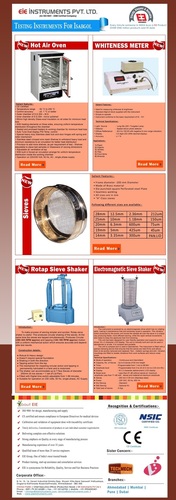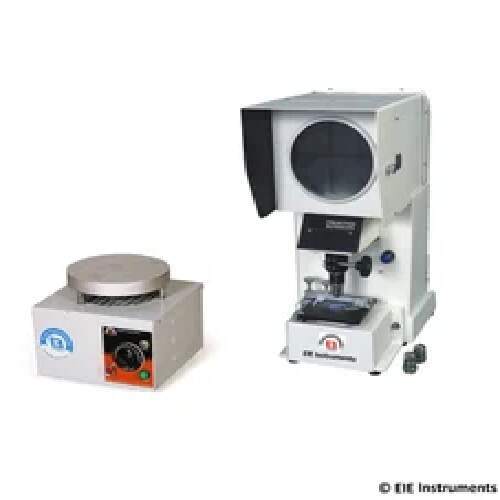Wear Tester For Road Marking Paints
Price 1.00 INR/ Piece
Wear Tester For Road Marking Paints Specification
- Accuracy
- 1 cycle
- Humidity
- Max. 80% RH
- Features
- Sturdy Design, Corrosion Resistant, Easy Operation
- Hardness
- Standard Paint Hardness
- Port Size
- 1/4 inch BSP
- Resolution
- 1 cycle
- Mounting Type
- Table Top
- Measuring Range
- 010000 cycles
- Application
- Wear Testing of Road Marking Paints
- Power Supply
- 230 V AC, 50 Hz
- Gas Pressure
- 2 4 bar
- Interface Type
- Push Button
- Automation Grade
- Semi-Automatic
- Equipment Type
- Wear Tester
- Operating Voltage
- 230 V
- Response Time
- <2 sec
- Test Range
- Up to 10000 cycles
- Max Height
- 600 mm
- Number of Specimens
- 1
- Display Type
- Digital LCD
- Temperature
- 15C 30C
- Frequency
- 50 Hz
- Specimen Size
- 200 mm x 75 mm
- Usage
- Industrial
- Capacity
- Single Phase
- Machine Weight
- Approx. 35 Kg
- Test Speed
- 60 cycles/minute
- Test Width
- 75 mm
- Test Stroke
- 600 mm
- Control Mode
- Digital Manual
Wear Tester For Road Marking Paints Trade Information
- Minimum Order Quantity
- 1 Piece
- FOB Port
- Ahmedabad
- Payment Terms
- Cash on Delivery (COD), Cheque, Letter of Credit at Sight (Sight L/C), Cash Against Delivery (CAD), Telegraphic Transfer (T/T), Cash in Advance (CID)
- Supply Ability
- 100 Pieces Per Year
- Delivery Time
- 3-4 Week
- Sample Policy
- Contact us for information regarding our sample policy
- Packaging Details
- Wooden packing with strong base
- Main Export Market(s)
- Australia, Africa, South America, Asia
- Main Domestic Market
- All India
- Certifications
- ISO 9001 : 2015
About Wear Tester For Road Marking Paints
Advanced Road Marking Paint Testing
Engineered for industrial usage, this wear tester evaluates the abrasion resistance of road marking paints with precision. Suited for laboratory environments, it measures paint wear over a range of up to 10,000 cycles. The user-friendly digital LCD interface and sturdy table-top design provide consistent results, supporting the needs of manufacturers, exporters, and quality control teams alike.
Built for Durability and Safety
With a robust powder-coated mild steel and aluminum body, the tester offers corrosion resistance and longevity. The emergency stop switch, manual cleaning system, and adjustable contact load ensure operator safety and convenient usage. Its compact build fits laboratory tables, providing ease of installation and operation.
FAQs of Wear Tester For Road Marking Paints:
Q: How is the Wear Tester for Road Marking Paints operated?
A: The tester operates with an electric motorized drive and is managed using a digital manual control panel with push-button interface. Simply secure the paint specimen using the precision fixed clamp, set the contact load up to 2 kg, and program the cycle count and speed as needed.Q: What types of specimens and tests can the equipment accommodate?
A: The tester is designed for one specimen measuring 200 mm x 75 mm at a time and supports wear testing of road marking paints up to 10,000 abrasion cycles, meeting IS standards for paint testing accuracy and consistency.Q: When should the emergency stop switch be used?
A: The emergency stop switch should be engaged immediately in case of any operational irregularity or safety concern during testing, ensuring prompt shutdown of the equipment for operator safety.Q: Where is this wear tester typically installed and used?
A: It is suited for indoor laboratories, particularly in industrial, manufacturing, or quality control settings involved in road marking paint testing and development.Q: What is the process for cleaning the equipment after use?
A: After completing a test, use the manual cleaning system to remove any paint residue from the machines contact parts, ensuring the equipment is clean and ready for future testing cycles.Q: How does the digital LCD display enhance usability?
A: The digital LCD display provides clear, real-time information on cycles completed, enhancing precision by offering 1 cycle accuracy and quick response within 2 seconds for better monitoring during the test process.Q: What benefits does this equipment offer compared to traditional methods?
A: Compared to manual methods, this wear tester delivers consistent, repeatable results with higher accuracy and time efficiency. Its adjustable load, standardized testing cycles, and robust construction improve the reliability and validity of road marking paint evaluations.

Price:
- 50
- 100
- 200
- 250
- 500
- 1000+
More Products in Thermo Plastic Road Marking Paints Testing Category
Marshall Rammer
Price 1.00 INR / Piece
Minimum Order Quantity : 1 Piece
Usage : Compaction of bituminous mixes for Marshall Test
Application : Soil, asphalt and bitumen testing, civil engineering labs
Response Time : Instantaneous operation on completion of cycle
Test Speed : Variable speed up to 55 blows per minute
Film Applicator
Price 1.00 INR / Piece
Minimum Order Quantity : 1 Piece
Usage : Laboratory and industrial film coating tests
Application : Uniform coating of films for laboratory testing
Response Time : Instantaneous
Test Speed : 0~50 mm/s adjustable
Chequer Board For Wet Opacity Test - As Per IS 101
Price 1.00 INR / Piece
Minimum Order Quantity : 1 Piece
Usage : Laboratory paint testing
Application : Testing wet opacity of paints as per IS 101
Response Time : Instantaneous (manual check)
Test Speed : Manual Operation
Carbon Black Dispersion Apparatus
Price 1.00 INR / Piece
Minimum Order Quantity : 1 Piece
Usage : laboratory
Application : Industrial
 |
EIE INSTRUMENTS PVT. LTD.
All Rights Reserved.(Terms of Use) Developed and Managed by Infocom Network Private Limited. |

 Send Inquiry
Send Inquiry




